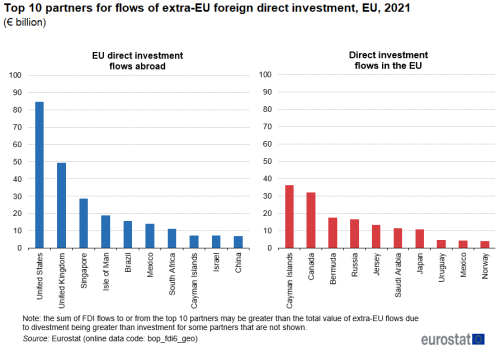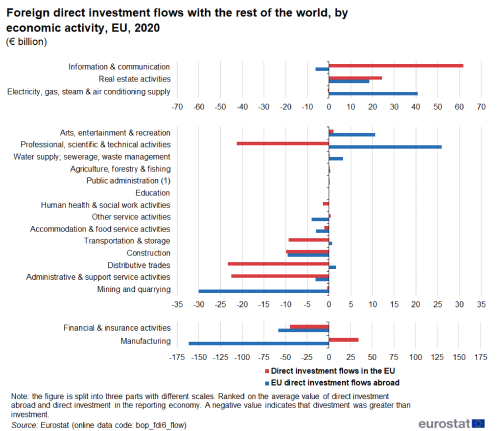Foreign direct investment - flows
Data extracted in July and August 2023.
Planned article update: August 2024.
Highlights
In 2021, the United States, the United Kingdom and Singapore dominated the EU's outward investment flows, while the Cayman Islands and Canada were the largest sources of inward investment flows.
In 2020, information and communication services accounted for the highest value of FDI flows into the EU Member States (€62 billion) and electricity, gas, steam and air conditioning supply for the highest value of FDI flows abroad from the Member States (€41 billion).

(€ billion)
Source: Eurostat (bop_fdi6_geo)
Globalisation patterns in EU trade and investment is an online Eurostat publication presenting a summary of recent European Union (EU) statistics on economic aspects of globalisation, focusing on patterns of EU trade and investment.
As with domestic investment, flows of foreign direct investment (FDI) can exhibit a very high degree of volatility from one year to the next. These changes may be linked to global economic events, sector-specific developments, or the individual situations of enterprises considering foreign investments. The information presented in this article examines flows of FDI between the EU and non-member countries.
The two analyses presented in this article – one by partner country and one by activity – are based on the latest data available: for the analysis by partner country, the most recent reference period is 2021; for the analysis by activity, the latest reference period is 2020. The overall level of inward and outward FDI flows were considerably different in 2021 from those in 2020, due in part to the developments during the COVID-19 pandemic.
Note the analysis by partner country is for the EU's FDI flows with non-member countries (also referred to as extra-EU flows). The analysis by activity includes not only extra-EU flows but also FDI flows between EU Member States (also referred to as intra-EU flows).
Full article
Recent developments in EU FDI flows
The time series available for the EU's FDI flows (based on the latest methodology) begins in 2013, several years after the global financial and economic crisis. By 2013, inward and outward flows of FDI had started to recover from that crisis. Nevertheless, investment flows followed a fluctuating pattern between 2013 and 2021, suggesting there was a sustained period of uncertainty among investors.
- Between 2013 and 2016, the development for the value of flows – both outward and inward – fluctuated between increases and decreases on an annual basis.
- The situation changed in 2017 as the value of EU investment flows fell for a second consecutive year, both for outward and inward flows; in 2018, a third consecutive annual fall was recorded as the flows turned negative (indicating reverse investment or disinvestment in both directions).
- In 2019, the value of the EU's FDI flows returned to positive – although relatively low – values.
- In 2020, the direction of change for the value of flows diverged for the first time during the period under consideration. The value for inward flows increased again, albeit by a smaller amount than in the previous year, while the value for outward flows declined.
- In 2021, the values for both flows again moved in the same direction as both fell. The value for inward flows decreased more strongly and turned negative, while the fall for the value of outward flows was more modest (and remained positive).
In 2021, the EU was a net investor, as the flow of FDI abroad was €262 billion higher than the level of inward investment.
EU FDI investment partners
In 2021, a sizeable proportion of the EU's outward flows of FDI were destined for the United States (€84.7 billion). The next largest outward flows were €49.2 billion to the United Kingdom and €28.7 billion to Singapore. The only other destinations to which investments from the EU exceeded €10.0 billion in 2021 were the Isle of Man (which is an offshore financial centre), Brazil, Mexico and South Africa (see Figure 1).
In 2021, the Cayman Islands – which is an offshore financial centre – was the biggest origin of inward investment flows into the EU, providing €36.2 billion of FDI, just ahead of Canada (€32.0 billion). Bermuda – another offshore financial centre – was the third largest source (with FDI into the EU valued at €17.4 billion), ahead of Russia (€16.5 billion). Jersey (another offshore financial centre), Saudi Arabia and Japan were the only other countries whose investments into the EU exceeded €10.0 billion in 2021.
The EU was a net recipient of FDI from 8 out of the 10 largest investors in the EU, the exceptions being Mexico and Norway. The EU was a net investor in 9 out of the top 10 destinations for its outward investment flows in 2021, the exception being the Cayman Islands.

(€ billion)
Source: Eurostat (bop_fdi6_geo)
EU FDI flows by activity
In 2020, information and communication accounted for the highest share of inward FDI flows into the EU Member States and electricity, gas, steam and air conditioning supply for the highest share of outward FDI flows from the Member States
In 2020, the largest flows of outward FDI from the EU Member States to the rest of the world (in other words, the sum of FDI flows within the EU and FDI flows to non-member countries) were recorded for electricity, gas, steam and air conditioning supply (€40.7 billion), professional, scientific and technical activities (€25.9 billion), real estate activities (€18.5 billion) and arts, entertainment and recreation (€10.6 billion). Information and communication recorded the highest value of inward investment flows (€61.7 billion) in 2020, followed by manufacturing (€34.5 billion) and real estate activities (€24.4 billion) – see Figure 2.

(€ billion)
Source: Eurostat (bop_fdi6_flow)
Source data for tables and graphs
Direct access to
- Balance of payments – International transactions (BPM6) (bop_6), see:
- European Union direct investments (BPM6) (bop_fdi6)
Metadata
- Balance of payments – international transactions (BPM6) (ESMS metadata file – bop_6_esms)
- European Union direct investments (BPM6) (ESMS metadata file – bop_fdi6_esms)
Further methodological information